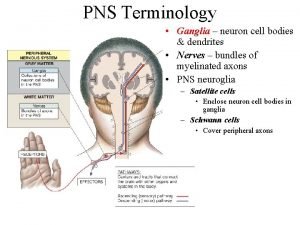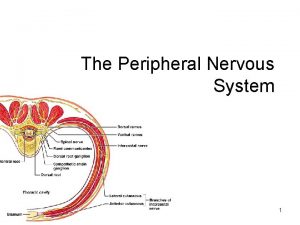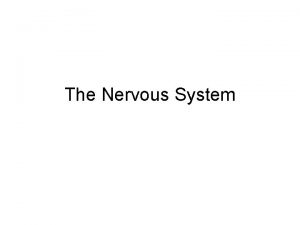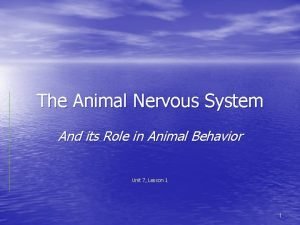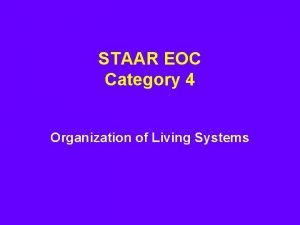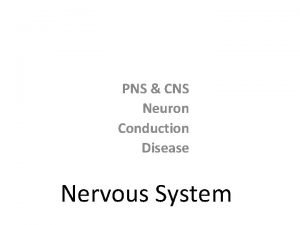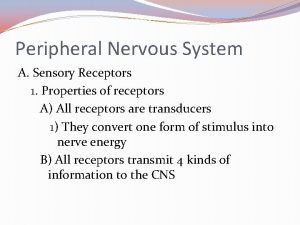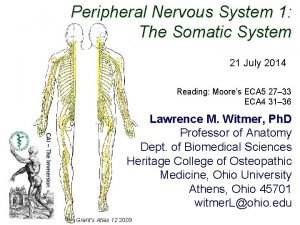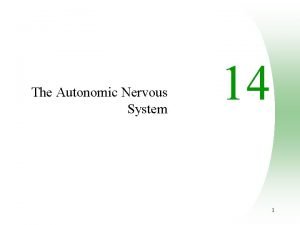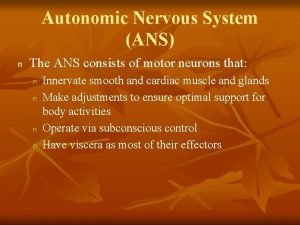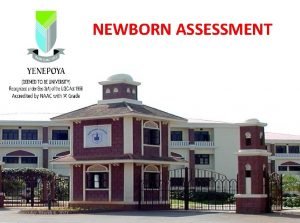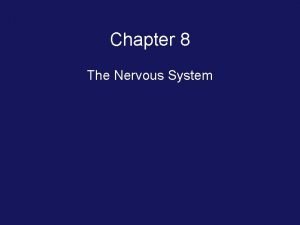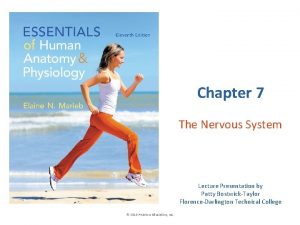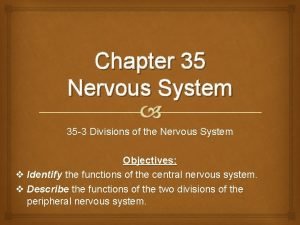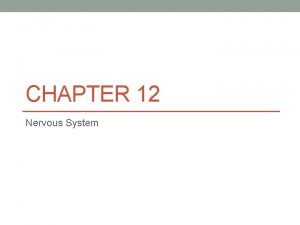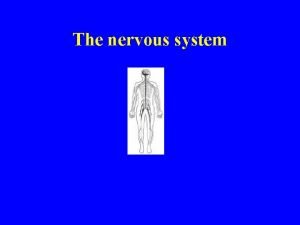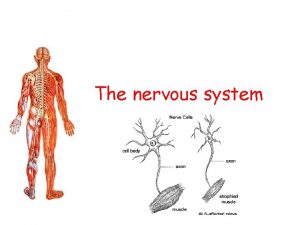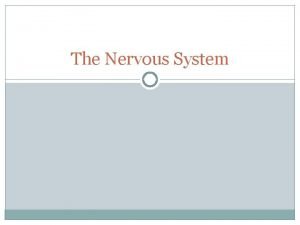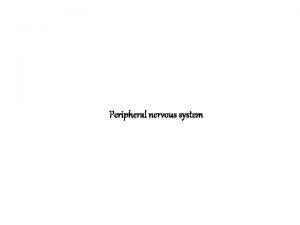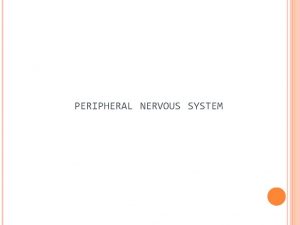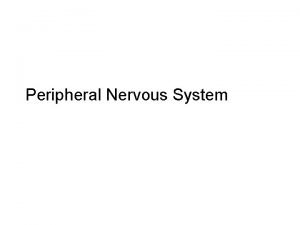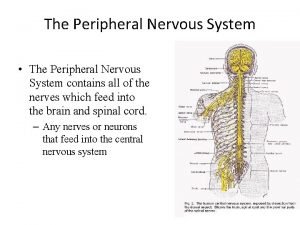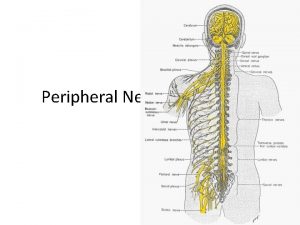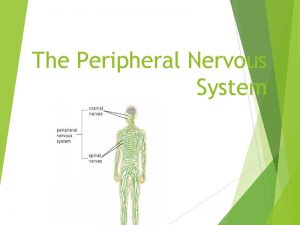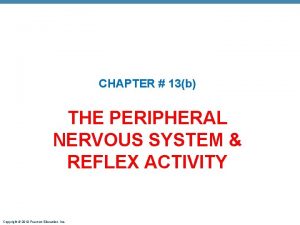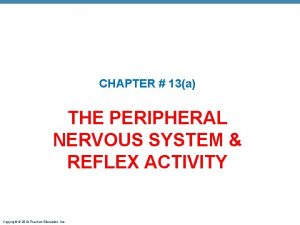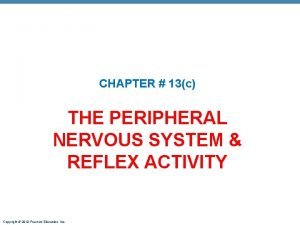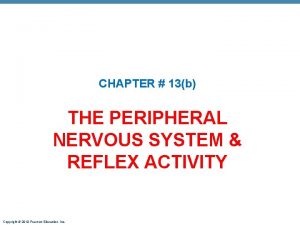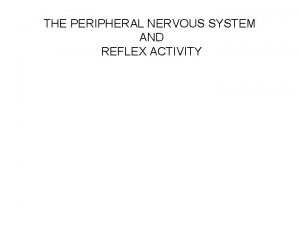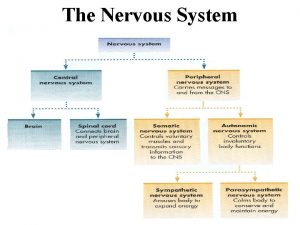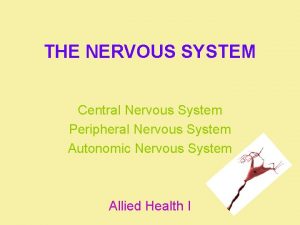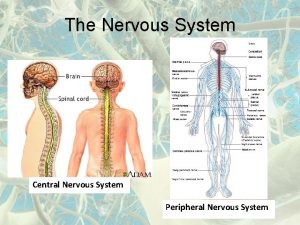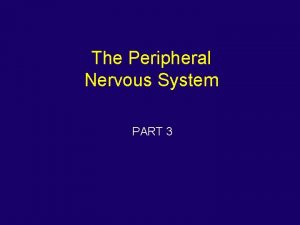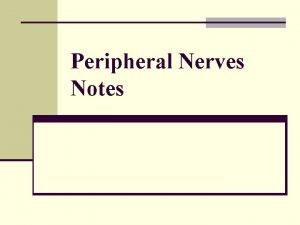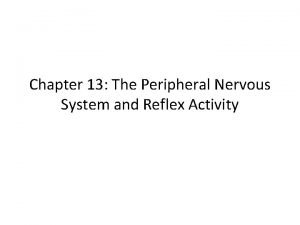CHAPTER 13d THE PERIPHERAL NERVOUS SYSTEM REFLEX ACTIVITY








































- Slides: 40

CHAPTER # 13(d) THE PERIPHERAL NERVOUS SYSTEM & REFLEX ACTIVITY Copyright © 2010 Pearson Education, Inc.

Reflexes • Inborn (intrinsic) reflex: a rapid, involuntary, predictable motor response to a stimulus • Learned (acquired) reflexes result from practice or repetition, • Example: driving skills Copyright © 2010 Pearson Education, Inc.

Reflex Arc • Components of a reflex arc (neural path) 1. Receptor—site of stimulus action 2. Sensory neuron—transmits afferent impulses to the CNS 3. Integration center—either monosynaptic or polysynaptic region within the CNS 4. Motor neuron—conducts efferent impulses from the integration center to an effector organ 5. Effector—muscle fiber or gland cell that responds to the efferent impulses by contracting or secreting Copyright © 2010 Pearson Education, Inc.

Stimulus Skin 1 Receptor Interneuron 2 Sensory neuron 3 Integration center 4 Motor neuron 5 Effector Spinal cord (in cross section) Copyright © 2010 Pearson Education, Inc. Figure 13. 14

Spinal Reflexes • Spinal somatic reflexes • Integration center is in the spinal cord • Effectors are skeletal muscle • Testing of somatic reflexes is important clinically to assess the condition of the nervous system Copyright © 2010 Pearson Education, Inc.

Stretch and Golgi Tendon Reflexes • For skeletal muscle activity to be smoothly coordinated, proprioceptor input is necessary • Muscle spindles inform the nervous system of the length of the muscle • Golgi tendon organs inform the brain as to the amount of tension in the muscle and tendons Copyright © 2010 Pearson Education, Inc.

Muscle Spindles • Composed of 3– 10 short intrafusal muscle fibers in a connective tissue capsule • Intrafusal fibers • Noncontractile in their central regions (lack myofilaments) • Wrapped with two types of afferent endings: primary sensory endings of type Ia fibers and secondary sensory endings of type II fibers Copyright © 2010 Pearson Education, Inc.

Muscle Spindles • Contractile end regions are innervated by gamma ( ) efferent fibers that maintain spindle sensitivity • Note: extrafusal fibers (contractile muscle fibers) are innervated by alpha ( ) efferent fibers Copyright © 2010 Pearson Education, Inc.

Secondary sensory endings (type II fiber) Primary sensory endings (type Ia fiber) Muscle spindle Connective tissue capsule Efferent (motor) fiber to muscle spindle Efferent (motor) fiber to extrafusal muscle fibers Extrafusal muscle fiber Intrafusal muscle fibers Sensory fiber Golgi tendon organ Copyright © 2010 Pearson Education, Inc. Tendon Figure 13. 15

Muscle Spindles • Excited in two ways: 1. External stretch of muscle and muscle spindle 2. Internal stretch of muscle spindle: • • Activating the motor neurons stimulates the ends to contract, thereby stretching the spindle Stretch causes an increased rate of impulses in Ia fibers Copyright © 2010 Pearson Education, Inc.

Muscle spindle Intrafusal muscle fiber Primary sensory (la) nerve fiber Extrafusal muscle fiber Copyright © 2010 Pearson Education, Inc. Time (a) Unstretched muscle. Action potentials (APs) are generated at a constant rate in the associated sensory (la) fiber. (b) Stretched muscle. Stretching activates the muscle spindle, increasing the rate of APs. Figure 13. 16 a, b

Muscle Spindles • Contracting the muscle reduces tension on the muscle spindle • Sensitivity would be lost unless the muscle spindle is shortened by impulses in the motor neurons • – coactivation maintains the tension and sensitivity of the spindle during muscle contraction Copyright © 2010 Pearson Education, Inc.

Time (c) Only motor (d) - Coactivation. neurons activated. Both extrafusal and intrafusal muscle Only the extrafusal muscle fibers contract. The muscle spindle Muscle spindle becomes slack and no tension is main. APs are fired. It is tained and it can unable to signal further still signal changes length changes. in length. Copyright © 2010 Pearson Education, Inc. Figure 13. 16 c, d

Stretch Reflexes • Maintain muscle tone in large postural muscles • Cause muscle contraction in response to increased muscle length (stretch) Copyright © 2010 Pearson Education, Inc.

Stretch Reflexes • How a stretch reflex works: • Stretch activates the muscle spindle • IIa sensory neurons synapse directly with motor neurons in the spinal cord • motor neurons cause the stretched muscle to contract • All stretch reflexes are monosynaptic and ipsilateral Copyright © 2010 Pearson Education, Inc.

Stretch Reflexes • Reciprocal inhibition also occurs—IIa fibers synapse with interneurons that inhibit the motor neurons of antagonistic muscles • Example: In the patellar reflex, the stretched muscle (quadriceps) contracts and the antagonists (hamstrings) relax Copyright © 2010 Pearson Education, Inc.

Stretched muscle spindles initiate a stretch reflex, causing contraction of the stretched muscle and inhibition of its antagonist. The events by which muscle stretch is damped 1 When muscle spindles are activated 2 The sensory neurons synapse directly with alpha motor neurons (red), which excite extrafusal fibers by stretch, the associated sensory of the stretched muscle. Afferent fibers also neurons (blue) transmit afferent impulses synapse with interneurons (green) that inhibit motor at higher frequency to the spinal cord. neurons (purple) controlling antagonistic muscles. Sensory neuron Cell body of sensory neuron Initial stimulus (muscle stretch) Spinal cord Muscle spindle Antagonist muscle 3 a Efferent impulses of alpha motor neurons 3 b Efferent impulses of alpha motor cause the stretched muscle to contract, which resists or reverses the stretch. neurons to antagonist muscles are reduced (reciprocal inhibition). Copyright © 2010 Pearson Education, Inc. Figure 13. 17 (1 of 2)

Stretched muscle spindles initiate a stretch reflex, causing contraction of the stretched muscle and inhibition of its antagonist. The events by which muscle stretch is damped 1 When muscle spindles are activated by stretch, the associated sensory neurons (blue) transmit afferent impulses at higher frequency to the spinal cord. Sensory neuron Cell body of sensory neuron Initial stimulus (muscle stretch) Spinal cord Muscle spindle Antagonist muscle Copyright © 2010 Pearson Education, Inc. Figure 13. 17 (1 of 2), step 1

Stretched muscle spindles initiate a stretch reflex, causing contraction of the stretched muscle and inhibition of its antagonist. The events by which muscle stretch is damped 1 When muscle spindles are activated 2 The sensory neurons synapse directly with alpha motor neurons (red), which excite extrafusal fibers by stretch, the associated sensory of the stretched muscle. Afferent fibers also neurons (blue) transmit afferent impulses synapse with interneurons (green) that inhibit motor at higher frequency to the spinal cord. neurons (purple) controlling antagonistic muscles. Sensory neuron Cell body of sensory neuron Initial stimulus (muscle stretch) Spinal cord Muscle spindle Antagonist muscle Copyright © 2010 Pearson Education, Inc. Figure 13. 17 (1 of 2), step 2

Stretched muscle spindles initiate a stretch reflex, causing contraction of the stretched muscle and inhibition of its antagonist. The events by which muscle stretch is damped 1 When muscle spindles are activated 2 The sensory neurons synapse directly with alpha motor neurons (red), which excite extrafusal fibers by stretch, the associated sensory of the stretched muscle. Afferent fibers also neurons (blue) transmit afferent impulses synapse with interneurons (green) that inhibit motor at higher frequency to the spinal cord. neurons (purple) controlling antagonistic muscles. Sensory neuron Cell body of sensory neuron Initial stimulus (muscle stretch) Spinal cord Muscle spindle Antagonist muscle 3 a Efferent impulses of alpha motor neurons cause the stretched muscle to contract, which resists or reverses the stretch. Copyright © 2010 Pearson Education, Inc. Figure 13. 17 (1 of 2), step 3 a

Stretched muscle spindles initiate a stretch reflex, causing contraction of the stretched muscle and inhibition of its antagonist. The events by which muscle stretch is damped 1 When muscle spindles are activated 2 The sensory neurons synapse directly with alpha motor neurons (red), which excite extrafusal fibers by stretch, the associated sensory of the stretched muscle. Afferent fibers also neurons (blue) transmit afferent impulses synapse with interneurons (green) that inhibit motor at higher frequency to the spinal cord. neurons (purple) controlling antagonistic muscles. Sensory neuron Cell body of sensory neuron Initial stimulus (muscle stretch) Spinal cord Muscle spindle Antagonist muscle 3 a Efferent impulses of alpha motor neurons 3 b Efferent impulses of alpha motor cause the stretched muscle to contract, which resists or reverses the stretch. neurons to antagonist muscles are reduced (reciprocal inhibition). Copyright © 2010 Pearson Education, Inc. Figure 13. 17 (1 of 2), step 3 b

The patellar (knee-jerk) reflex—a specific example of a stretch reflex 2 Quadriceps (extensors) 1 Muscle spindle 3 a 3 b 3 b Patella Spinal cord (L 2–L 4) Hamstrings (flexors) Patellar ligament 1 Tapping the patellar ligament excites muscle spindles in the quadriceps. 2 Afferent impulses (blue) travel to the spinal cord, where synapses occur with motor neurons and interneurons. 3 a The motor neurons (red) send + – Excitatory synapse Inhibitory synapse activating impulses to the quadriceps causing it to contract, extending the knee. 3 b The interneurons (green) make inhibitory synapses with ventral horn neurons (purple) that prevent the antagonist muscles (hamstrings) from resisting the contraction of the quadriceps. Copyright © 2010 Pearson Education, Inc. Figure 13. 17 (2 of 2)

The patellar (knee-jerk) reflex—a specific example of a stretch reflex Quadriceps (extensors) 1 Muscle spindle Spinal cord (L 2–L 4) Hamstrings (flexors) + – Patellar ligament 1 Tapping the patellar ligament excites muscle spindles in the quadriceps. Excitatory synapse Inhibitory synapse Copyright © 2010 Pearson Education, Inc. Figure 13. 17 (2 of 2), step 1

The patellar (knee-jerk) reflex—a specific example of a stretch reflex 2 Quadriceps (extensors) 1 Muscle spindle Spinal cord (L 2–L 4) Hamstrings (flexors) + – Patellar ligament 1 Tapping the patellar ligament excites muscle spindles in the quadriceps. 2 Afferent impulses (blue) travel to the spinal cord, where synapses occur with motor neurons and interneurons. Excitatory synapse Inhibitory synapse Copyright © 2010 Pearson Education, Inc. Figure 13. 17 (2 of 2), step 2

The patellar (knee-jerk) reflex—a specific example of a stretch reflex 2 Quadriceps (extensors) 1 Muscle spindle 3 a Patella Spinal cord (L 2–L 4) Hamstrings (flexors) Patellar ligament 1 Tapping the patellar ligament excites muscle spindles in the quadriceps. 2 Afferent impulses (blue) travel to the spinal cord, where synapses occur with motor neurons and interneurons. 3 a The motor neurons (red) send + – Excitatory synapse Inhibitory synapse Copyright © 2010 Pearson Education, Inc. activating impulses to the quadriceps causing it to contract, extending the knee. Figure 13. 17 (2 of 2), step 3 a

The patellar (knee-jerk) reflex—a specific example of a stretch reflex 2 Quadriceps (extensors) 1 Muscle spindle 3 a 3 b 3 b Patella Spinal cord (L 2–L 4) Hamstrings (flexors) Patellar ligament 1 Tapping the patellar ligament excites muscle spindles in the quadriceps. 2 Afferent impulses (blue) travel to the spinal cord, where synapses occur with motor neurons and interneurons. 3 a The motor neurons (red) send + – Excitatory synapse Inhibitory synapse activating impulses to the quadriceps causing it to contract, extending the knee. 3 b The interneurons (green) make inhibitory synapses with ventral horn neurons (purple) that prevent the antagonist muscles (hamstrings) from resisting the contraction of the quadriceps. Copyright © 2010 Pearson Education, Inc. Figure 13. 17 (2 of 2), step 3 b

Golgi Tendon Reflexes • Polysynaptic reflexes • Help to prevent damage due to excessive stretch • Important for smooth onset and termination of muscle contraction Copyright © 2010 Pearson Education, Inc.

Golgi Tendon Reflexes • Produce muscle relaxation (lengthening) in response to tension • Contraction or passive stretch activates Golgi tendon organs • Afferent impulses are transmitted to spinal cord • Contracting muscle relaxes and the antagonist contracts (reciprocal activation) • Information transmitted simultaneously to the cerebellum is used to adjust muscle tension Copyright © 2010 Pearson Education, Inc.

1 Quadriceps strongly contracts. Golgi tendon organs are activated. 2 Afferent fibers synapse with interneurons in the spinal cord. Interneurons Quadriceps (extensors) Golgi tendon organ Spinal cord Hamstrings (flexors) 3 a Efferent impulses + Excitatory synapse – Inhibitory synapse Copyright © 2010 Pearson Education, Inc. to muscle with stretched tendon are damped. Muscle relaxes, reducing tension. 3 b Efferent impulses to antagonist muscle cause it to contract. Figure 13. 18

1 Quadriceps strongly contracts. Golgi tendon organs are activated. Interneurons Quadriceps (extensors) Golgi tendon organ Spinal cord Hamstrings (flexors) + Excitatory synapse – Inhibitory synapse Copyright © 2010 Pearson Education, Inc. Figure 13. 18, step 1

1 Quadriceps strongly contracts. Golgi tendon organs are activated. 2 Afferent fibers synapse with interneurons in the spinal cord. Interneurons Quadriceps (extensors) Golgi tendon organ Spinal cord Hamstrings (flexors) + Excitatory synapse – Inhibitory synapse Copyright © 2010 Pearson Education, Inc. Figure 13. 18, step 2

1 Quadriceps strongly contracts. Golgi tendon organs are activated. 2 Afferent fibers synapse with interneurons in the spinal cord. Interneurons Quadriceps (extensors) Golgi tendon organ Spinal cord Hamstrings (flexors) 3 a Efferent impulses + Excitatory synapse – Inhibitory synapse Copyright © 2010 Pearson Education, Inc. to muscle with stretched tendon are damped. Muscle relaxes, reducing tension. Figure 13. 18, step 3 a

1 Quadriceps strongly contracts. Golgi tendon organs are activated. 2 Afferent fibers synapse with interneurons in the spinal cord. Interneurons Quadriceps (extensors) Golgi tendon organ Spinal cord Hamstrings (flexors) 3 a Efferent impulses + Excitatory synapse – Inhibitory synapse Copyright © 2010 Pearson Education, Inc. to muscle with stretched tendon are damped. Muscle relaxes, reducing tension. 3 b Efferent impulses to antagonist muscle cause it to contract. Figure 13. 18, step 3 b

Flexor and Crossed-Extensor Reflexes • Flexor (withdrawal) reflex • Initiated by a painful stimulus • Causes automatic withdrawal of the threatened body part • Ipsilateral and polysynaptic Copyright © 2010 Pearson Education, Inc.

Flexor and Crossed-Extensor Reflexes • Crossed extensor reflex • Occurs with flexor reflexes in weight-bearing limbs to maintain balance • Consists of an ipsilateral flexor reflex and a contralateral extensor reflex • The stimulated side is withdrawn (flexed) • The contralateral side is extended Copyright © 2010 Pearson Education, Inc.

+ Excitatory synapse – Inhibitory synapse Interneurons Efferent fibers Afferent fiber Efferent fibers Extensor inhibited Flexor stimulated Site of stimulus: a noxious stimulus causes a flexor reflex on the same side, withdrawing that limb. Copyright © 2010 Pearson Education, Inc. Arm movements Flexor inhibited Extensor stimulated Site of reciprocal activation: At the same time, the extensor muscles on the opposite side are activated. Figure 13. 19

Superficial Reflexes • Elicited by gentle cutaneous stimulation • Depend on upper motor pathways and cordlevel reflex arcs Copyright © 2010 Pearson Education, Inc.

Superficial Reflexes • Plantar reflex • Stimulus: stroking lateral aspect of the sole of the foot • Response: downward flexion of the toes • Tests for function of corticospinal tracts Copyright © 2010 Pearson Education, Inc.

Superficial Reflexes • Babinski’s sign • Stimulus: as above • Response: dorsiflexion of hallux and fanning of toes • Present in infants due to incomplete myelination • In adults, indicates corticospinal or motor cortex damage Copyright © 2010 Pearson Education, Inc.

Superficial Reflexes • Abdominal reflexes • Cause contraction of abdominal muscles and movement of the umbilicus in response to stroking of the skin • Vary in intensity from one person to another • Absent when corticospinal tract lesions are present Copyright © 2010 Pearson Education, Inc.
 Neural circuits the organization of neuronal pools
Neural circuits the organization of neuronal pools Nervous
Nervous Nerve cell process
Nerve cell process Medunerve
Medunerve Division of nervous system
Division of nervous system Cranial nerves labeled
Cranial nerves labeled Peripheral nervous system
Peripheral nervous system Arthropod nervous system
Arthropod nervous system Peripheral nervous system consists of
Peripheral nervous system consists of Youtub.eoc
Youtub.eoc Wikimedia commons
Wikimedia commons Peripheral nervous system
Peripheral nervous system Pns nervous system
Pns nervous system Guilllain barre
Guilllain barre Migranal
Migranal Peripheral nervous sysytem
Peripheral nervous sysytem Building vocabulary activity: the central nervous system
Building vocabulary activity: the central nervous system Somatic reflex vs visceral reflex
Somatic reflex vs visceral reflex Somatic reflex vs visceral reflex
Somatic reflex vs visceral reflex Square window ballard
Square window ballard Nervous system and digestive system
Nervous system and digestive system Endocrine system and nervous system
Endocrine system and nervous system General mechanism of hormone action
General mechanism of hormone action Adh function
Adh function Chapter 7 the nervous system
Chapter 7 the nervous system Chapter 15 nervous system diseases and disorders
Chapter 15 nervous system diseases and disorders Chapter 8 the nervous system
Chapter 8 the nervous system Chapter 7 the nervous system figure 7-2
Chapter 7 the nervous system figure 7-2 Chapter 35 nervous system
Chapter 35 nervous system Chapter 14 the skeletal muscular and nervous systems
Chapter 14 the skeletal muscular and nervous systems Chapter 12 nervous system
Chapter 12 nervous system Chemical messengers of the nervous system
Chemical messengers of the nervous system Flatworm asexual reproduction
Flatworm asexual reproduction The nervous system is made up of
The nervous system is made up of Three basic functions of the nervous system
Three basic functions of the nervous system Nervous system learning objectives
Nervous system learning objectives Stimulus in nervous system
Stimulus in nervous system Nervous system objectives
Nervous system objectives Adrenal gland sympathetic nervous system
Adrenal gland sympathetic nervous system Nervous system def
Nervous system def Plexuses
Plexuses



